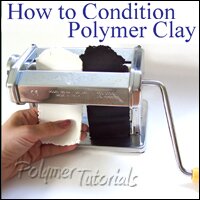How to Condition Polymer Clay
| Polymer clay has to be conditioned (thoroughly mixed) prior to use. It is required because the composition of polymer clay changes slightly during its storage due to evaporation and leaching of its plasticizers. You will want to have the same amount of plasticizers in every piece of clay you are using. Otherwise, the clay will behave differently during sculpting and baking. Also, the clay becomes more pliable as a result of conditioning. Depending on the brand, polymer clay will be more or less stiff at the beginning, and it gets softer as you condition it (more on differences among the Polymer Clay Brands). |
 |
If your clay is very stiff
To make conditioning easier, start with warming up your clay. The gentlest way of doing it is to carry the clay in your pocket for a while. If you do not need the entire brick of clay for your project, slice a piece of clay about 1/8 " to 1/4 " thick and put it into a zip-lock bag, then put the bag into your pocket for at least a few minutes. Some people prefer sitting on their clay to warm it up, which is also an option. Alternatively, you may try to warm the clay on a sunny windowsill, but keep a close eye on it and leave the clay there for no more than a few minutes (you do not want it to start curing yet, right?).
You are ready to start conditioning your clay once it feels pliable. Expect to be able to squeeze the clay with some effort. It shall feel similar to a therapeutic rubber ball, but not like play dough.
To condition polymer clay by hand, simply mix it and squish it with your fingers. You may want to roll it into a log between your palms, fold it in half, and then roll again. The smaller the piece of clay you are conditioning, the faster it will soften up.
Alternatively, you may want to use your pasta machine to condition your clay. Do not forget to flatten the clay to at least 1/4 " thickness before you put it though the pasta machine for the first time, otherwise the machine rollers may become misaligned. Use the highest (the thickest) setting on your pasta machine. Roll a sheet of clay, fold it in half, and then roll again on the same setting. Repeat it as many times as needed to soften the clay. Make sure to feed the folded part first into the machine to avoid trapping any air in the clay. Trapped air bubbles tend to expand during baking and may cause bulging of the clay surface.
Page 1 of 2



